VIEWPOINTS – Impressions of Cirque du Soleil Over the Years
- By drediman
- May 19, 2014
- No Comments
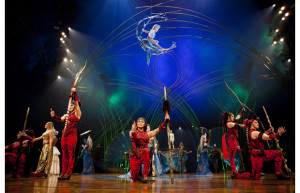 This past weekend, I caught a performance of “Amaluna”, the latest Cirque du Soleil tent show to grace the New York area. As I exited the big top set up in the parking lot of Citi Field, I was pleasantly surprised by how much I enjoyed this latest show (which is loosely based on Shakespeare’s “The Tempest” and features a cast that is 70% women), given Cirque’s spotty track record with me in recent years. The lackluster “Banana Shpeel” and “Zarkana”, for example, have tainted my once mostly favorable perception of the Canadian entertainment juggernaut. Seeing the propulsive and sexy “Amaluna”, tightly directed by Tony-winning Diane Paulus fresh from her work on the triumphant revival of “Pippin” on Broadway (which also strongly relies on circus arts), has reminded me of the qualities that made me fall in love with Cirque du Soleil in the first place and prompted me to look back at my Cirque experiences over the years.
This past weekend, I caught a performance of “Amaluna”, the latest Cirque du Soleil tent show to grace the New York area. As I exited the big top set up in the parking lot of Citi Field, I was pleasantly surprised by how much I enjoyed this latest show (which is loosely based on Shakespeare’s “The Tempest” and features a cast that is 70% women), given Cirque’s spotty track record with me in recent years. The lackluster “Banana Shpeel” and “Zarkana”, for example, have tainted my once mostly favorable perception of the Canadian entertainment juggernaut. Seeing the propulsive and sexy “Amaluna”, tightly directed by Tony-winning Diane Paulus fresh from her work on the triumphant revival of “Pippin” on Broadway (which also strongly relies on circus arts), has reminded me of the qualities that made me fall in love with Cirque du Soleil in the first place and prompted me to look back at my Cirque experiences over the years.
The first experience is usually the most memorable
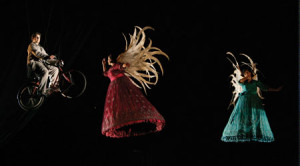 For nearly three decades, Cirque du Soleil has worked its way into global popular culture, prolifically opening new shows and tirelessly touring the world-over. I’ve seen nearly all their shows (I’ve seen 14 in total) in various cities in North America, including their large-scale resident shows in Las Vegas. Looking back, I must say that I have had a love-hate relationship with Cirque shows: nearly all are uneven and heavy-handed affairs that tend to recycle a limited repertoire of underlying circus acts, resulting in repetitious, albeit impressive, experiences for repeat customers. Therefore, it’s likely that your first Cirque experience is also your favorite. For me, the unadulterated joy of seeing the glorious Fellini-esque “Corteo” in Chicago (circa 2006) remains one of the most vivid performing arts experiences of my lifetime. The impression of that first foray and the childlike wonder it induced in me is what draws me back to Cirque shows time and time again.
For nearly three decades, Cirque du Soleil has worked its way into global popular culture, prolifically opening new shows and tirelessly touring the world-over. I’ve seen nearly all their shows (I’ve seen 14 in total) in various cities in North America, including their large-scale resident shows in Las Vegas. Looking back, I must say that I have had a love-hate relationship with Cirque shows: nearly all are uneven and heavy-handed affairs that tend to recycle a limited repertoire of underlying circus acts, resulting in repetitious, albeit impressive, experiences for repeat customers. Therefore, it’s likely that your first Cirque experience is also your favorite. For me, the unadulterated joy of seeing the glorious Fellini-esque “Corteo” in Chicago (circa 2006) remains one of the most vivid performing arts experiences of my lifetime. The impression of that first foray and the childlike wonder it induced in me is what draws me back to Cirque shows time and time again.
The magic of Cirque under a tent
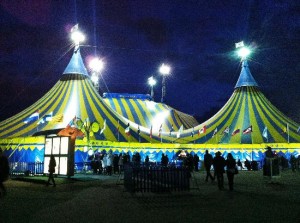 Cirque du Soleil has always excelled at creating transporting, immersive worlds, especially when that world is showcased under their signature yellow and blue tent. Really, the best way to first experience Cirque is through one of their classic shows under the big top. These intimate, nearly in-the-round productions do a great job of immersing the audience into their wolds by bringing the performance to them. The design teams are usually superb, creating environmental worlds by extending their work to surround the audience and not restricting scenic elements to just within the performance space. Also, under a standalone tent, the whole experience somehow feels more spontaneous, personal, and even subversive (a lot of the action takes place among the audience, which many times include extreme audience participation) than in the larger Cirque shows I’ll be discussing later. By the show’s end, I’m usually moved not only by the intoxicating fantasy world created, but also by the sense of community among the performers that is most evident within the intimate environs of the original tent format. Like the aforementioned “Amaluna” and “Corteo”, other memorable tent shows that I’ve experienced include “Ovo”, “Kooza”, and “Totem”, the latter two directed by theater notables, David Shiner and Robert Lepage, respectively.
Cirque du Soleil has always excelled at creating transporting, immersive worlds, especially when that world is showcased under their signature yellow and blue tent. Really, the best way to first experience Cirque is through one of their classic shows under the big top. These intimate, nearly in-the-round productions do a great job of immersing the audience into their wolds by bringing the performance to them. The design teams are usually superb, creating environmental worlds by extending their work to surround the audience and not restricting scenic elements to just within the performance space. Also, under a standalone tent, the whole experience somehow feels more spontaneous, personal, and even subversive (a lot of the action takes place among the audience, which many times include extreme audience participation) than in the larger Cirque shows I’ll be discussing later. By the show’s end, I’m usually moved not only by the intoxicating fantasy world created, but also by the sense of community among the performers that is most evident within the intimate environs of the original tent format. Like the aforementioned “Amaluna” and “Corteo”, other memorable tent shows that I’ve experienced include “Ovo”, “Kooza”, and “Totem”, the latter two directed by theater notables, David Shiner and Robert Lepage, respectively.
Cirque conquers Las Vegas
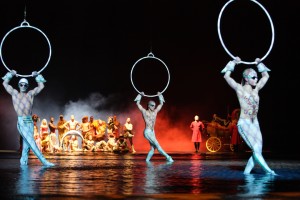 With their increasing popularity in the 1990s as result of their well-received tent shows, Cirque du Soleil set out to conquer Las Vegas with even more spectacular resident shows staged in theaters specifically built for them. As expected, some of the shows aimed to sync with your usual Vegas fare, for example by reinterpreting the songbooks of Elvis (the now closed “Viva Elvis”) and the Beatles (“Love”, currently running). However, I feel that the more successful Vegas shows are the ones that intensify and explode the otherworldly tent experiences that made Cirque successful in the first place. These even more elaborate shows include the now-classic trio of “Mystere”, “O”, and “Ka”. All three are technical wonders, and surely some of the most visually astounding shows I have ever seen (particularly the monumental visual feats of the mesmerizing, water-focused “O” and the awe-inspiring, physically imposing “Ka”). Certainly, what’s lost by way of sense of community and immersion is compensated by sheer scale and boldness of vision.
With their increasing popularity in the 1990s as result of their well-received tent shows, Cirque du Soleil set out to conquer Las Vegas with even more spectacular resident shows staged in theaters specifically built for them. As expected, some of the shows aimed to sync with your usual Vegas fare, for example by reinterpreting the songbooks of Elvis (the now closed “Viva Elvis”) and the Beatles (“Love”, currently running). However, I feel that the more successful Vegas shows are the ones that intensify and explode the otherworldly tent experiences that made Cirque successful in the first place. These even more elaborate shows include the now-classic trio of “Mystere”, “O”, and “Ka”. All three are technical wonders, and surely some of the most visually astounding shows I have ever seen (particularly the monumental visual feats of the mesmerizing, water-focused “O” and the awe-inspiring, physically imposing “Ka”). Certainly, what’s lost by way of sense of community and immersion is compensated by sheer scale and boldness of vision.
Mediocre experiments
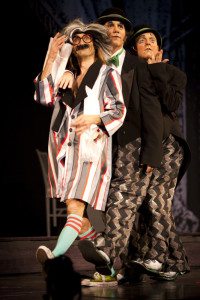 After the tremendous success of their Vegas shows, Cirque du Soleil started experimenting with other approaches to and venues for their shows. I applaud their pushing the boundaries, but as is the nature with experiments, there is always the risk of artistic failure. Clowning has never been Cirque’s strong suit. Most of the time, it’s painfully clear that the reason for their inclusion in shows is to buy some transition time for the upcoming set piece. Even worse, sometimes these clowning interludes overstay their welcome and are just plain tedious and unfunny. So when Cirque decided to build a show around clowning antics in their show “Banana Shpeel”, I had a feeling of dread. Not surprisingly, the show felt like it was forced out of a corporate machine and turned out to be a resoundingly dismal dud. Also, in recent years, Cirque has experimented with presenting their shows in different types of venues. For example, “Zarkana” was performed in a traditional proscenium theater (I saw its world premier at Radio City Music Hall). Performing behind a fourth wall, especially in a large theater, dampened the impact of the experience, and I found this less immersive side to Cirque distancing, even boring at times. Additionally, some Cirque shows have been designed (like “Michael Jackson: The Immortal World Tour”) or retrofitted (to breathe new life into older, much-loved tent shows like “Saltibanco”) to play large arenas, in order to maximize profits and mobility. Despite their efforts to make these experiences immersive ones, the arenas the shows play in are simply too large, again resulting in somewhat muted experiences. Simply put, the way to experience Cirque remains under a tent or by booking a flight to Vegas.
After the tremendous success of their Vegas shows, Cirque du Soleil started experimenting with other approaches to and venues for their shows. I applaud their pushing the boundaries, but as is the nature with experiments, there is always the risk of artistic failure. Clowning has never been Cirque’s strong suit. Most of the time, it’s painfully clear that the reason for their inclusion in shows is to buy some transition time for the upcoming set piece. Even worse, sometimes these clowning interludes overstay their welcome and are just plain tedious and unfunny. So when Cirque decided to build a show around clowning antics in their show “Banana Shpeel”, I had a feeling of dread. Not surprisingly, the show felt like it was forced out of a corporate machine and turned out to be a resoundingly dismal dud. Also, in recent years, Cirque has experimented with presenting their shows in different types of venues. For example, “Zarkana” was performed in a traditional proscenium theater (I saw its world premier at Radio City Music Hall). Performing behind a fourth wall, especially in a large theater, dampened the impact of the experience, and I found this less immersive side to Cirque distancing, even boring at times. Additionally, some Cirque shows have been designed (like “Michael Jackson: The Immortal World Tour”) or retrofitted (to breathe new life into older, much-loved tent shows like “Saltibanco”) to play large arenas, in order to maximize profits and mobility. Despite their efforts to make these experiences immersive ones, the arenas the shows play in are simply too large, again resulting in somewhat muted experiences. Simply put, the way to experience Cirque remains under a tent or by booking a flight to Vegas.
After experiencing the wonderful “Amaluna”, I’m hopeful that Cirque du Soleil will more confidently find its footing in future productions. It would be a huge shame if this famed company, which is responsible for countless delightful and extraordinary visions, were to lose its unique artistic pulse and collapse under its own corporate weight.

 Copyright © 2025
Copyright © 2025
Leave a Reply